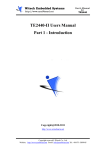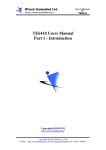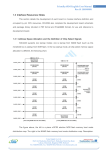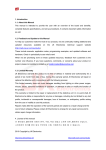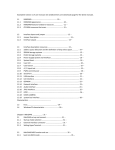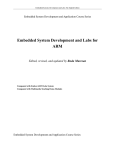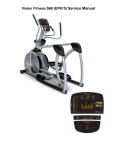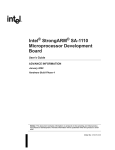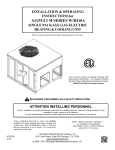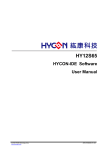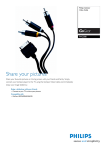Download FL2440 Users Manual - Embedded ARM9 and ARM11
Transcript
FL2440 Users Manual Copyright@2010-2011 http://www.arm9board.net Website: Copyright reserved© Witech Co., Ltd. http://www.arm9board.net Email: [email protected] Tel: +86-871-5899845 COPYRIGHT STATEMENT Contents (content being images, text, programs and scripts) of this manual is copyright © Witech Co., Ltd. All rights expressly reserved. Any content of the manual printed or downloaded may not be sold, licensed, transferred, copied or reproduced in whole or in part in any manner or in or on any media to any person without the prior written consent of Witech Systems Ltd. including but not limited to: z transmission by any method z storage in any medium, system or program z display in any form z performance z hire, lease, rental or loan Requests for permission to reproduce material from this manual should be addressed to Witech Systems Ltd. Website: Copyright reserved© Witech Co., Ltd. http://www.arm9board.net Email: [email protected] Tel: +86-871-5899845 FL2440 is a development board released by Witech Embedded for the Samsung S3C2440; it is split into two parts: 6-layer core board and a 2-layer application board, such structure not only makes the FL2440 more flexible and also more convenience for maintenance. The layout and wiring on the FL2440 are professionally designed, to make the FL2440 development board more stable and reliable performance. Together with the FL2440 we provide BSPs (Board Support Packages) for Embedded Linux and WindowsCE including basic drivers for all the components on the board and illustrating programs, which we believe can help the users in understanding the ARM architecture and shortening their development circle. Here are some dos and don’ts for using the FL2440: 1. After opening the FL2440 package, please check and make sure that the following components are all enclosed: 2. 3. 4. 5. 6. z 1 × FL2440 board z 1 × serial port cable z 1 × USB cable z 1 × Ethernet cable z 1 × JTAG wiggler with JTAG cable z 1 × 5V power supply z 1 × DVD After purchasing the FL2440, please do inform us with your purchase information, including your name, registered email address, purchase date, invoice number and board ID to validate your membership for downloading the latest data from our website. When using the development board for the first time, please do read and follow the user manual to prevent unnecessary troubles and damages. Every time before powering on the development board, please touch anyone of the metallic interface with your fingers to unload the Electrostatic. Do not touch the chips with your fingers! Before physically operating the development board, please switch the power off. Hot plugging is NOT supported except on the USB and Ethernet interfaces. We provide for the FL2440 12 weeks’ guarantee (in the precondition of non-artificial damage) and 24 weeks technical support. Editor: Witech Co. Ltd. Tel: 86-871-5899845 Fax: 86-871-5899845 Email: [email protected] Website: http://www.arm9board.net/ Website: Copyright reserved© Witech Co., Ltd. http://www.arm9board.net Email: [email protected] Tel: +86-871-5899845 Chapter One: Hardware Introduction The FL2440 Development board consists of a 6-layer core board and a 4-layer application board. Layout and wiring on the FL2440 is meticulously designed by professionals to ensure stable performance, which, together with a variety of interfaces, connectors, and ports, makes the FL2440 a reliable device for the development of hand-held device, consumer electronics and Industrial control equipment. 1.1 Components in the Package Standard Components: 1. 1 × FL2440 board 2. 1 × serial port cable 3. 1 × USB cable 4. 1 × Ethernet cable 5. 1 × JTAG wiggler with JTAG cable 6. 1 × 5V power supply 7. 1 × DVD Optional Components: 1. 3.5” TFT LCD with touch panel and stylus. 2. 5.7” TFT LCD with touch panel and stylus. 3. 7” TFT LCD with touch panel and stylus. 4. OV9650 CMOS camera 5. USB camera 6. WIFI module 1.2 DVD contents The DVD includes some documents and development resources for the FL2440 development board. In the DVD: ♦ The folder named as “bootloader” contains the source code and object files of the bootloader. Website: Copyright reserved© Witech Co., Ltd. http://www.arm9board.net Email: [email protected] Tel: +86-871-5899845 ♦ Folder “Linux” contains kernel source code, filesystem and some related tools for Linux-2.6.12 and Linux-2.6.28. ♦ Folder “WinCE” contains the WindowsCE BSP source code, SDK, test program and binaries. ♦ Folder “ucos2” contains the source code and binaries of ucos2 operating system. ♦ “Drivers” contains USB driver, parallel port driver, JLINK driver, ActiveSync driver and USB-RS232 driver for the PC. ♦ “Schematics” contains the schematic of the FL2440 application board and layout of the core board. ♦ “Demos” contains demonstration programs. ♦ “Tools” contains some utility programs such as DNW, H-JTAG, ActiveSync. ♦ “Datasheets” contains datasheets for the major on-board components and chips. ♦ “HardwareTest” contains the source code and binaries for the hardware test program. ♦ “Manuals” contains user manuals and operation instructions in PDF. Website: Copyright reserved© Witech Co., Ltd. http://www.arm9board.net Email: [email protected] Tel: +86-871-5899845 1.3 Appearance 1.4 Hardware Resources CPU: ¾ Samsung S3C2440A microcontroller, running @400MHz RAM: ¾ 64MB SDRAM Flash: ¾ 4MB NOR Flash ¾ 256MB Nand Flash Serial Ports: ¾ One 5-wire serial ports, baud rate @ 115200bps; ¾ One 3-wire serial port, baud rate @ 115200bps; ¾ One-3-wire expansion interface; ¾ The three serial ports can be used simultaneously. Website: Copyright reserved© Witech Co., Ltd. http://www.arm9board.net Email: [email protected] Tel: +86-871-5899845 Ethernet Ports: ¾ One 100M Ethernet with connection and transmission indicator, using DM9000 USB Interfaces ¾ Four USB1.1 Host interfaces ¾ One USB1.1 Device interface Audio: ¾ One stereo audio output socket for earphone or speaker, using IIS interface chip UDA1341 Storage Interfaces: ¾ One SD card slot LCD&Touch Interface: ¾ On-board 4-wire resistive touch screen interface ¾ One 40-pin LCD connector ¾ Support black and white, 4 level grayscale, 16 level grayscale, 256-color, 4096-color STN LCD Camera connector: ¾ One 20p 2.0mm pitch camera connector Clock source: ¾ Built-in real time clock Reset Circuit: ¾ One reset button with specific reset chip JTAG Interface: ¾ One 20pin Multi-ICE JTAG interface, supporting SDT2.51, ADS1.2 Power Supply: ¾ 5V power supply with power switch and indicator Others: ¾ Website: Four user buttons Copyright reserved© Witech Co., Ltd. http://www.arm9board.net Email: [email protected] Tel: +86-871-5899845 ¾ Four user LEDs ¾ One PWM controlling buzzer ¾ One adjustable resistance connected to ADC pins for A/D conversion ¾ One infrared receiver (optional) ¾ One temperature sensor (optional) Website: Copyright reserved© Witech Co., Ltd. http://www.arm9board.net Email: [email protected] Tel: +86-871-5899845 1.5 Hardware Resource Distribution 1.5.1 Address Space and Chip Selection The FL2440 can be boot from either Nand Flash or NOR Flash. The distribution of storage space is different when booting from each Flash, as shown in the figure below: The left drawing is the memory allocation diagram when the system is set to the Nor Flash boot mode with nGCS0 being set. The right drawing is the memory allocation diagram when the system is set to the Nand Flash boot mode. Note: SFR Area is reserved for special registers nGCS0 will map its address space to different devices when the system boots in different modes - When the system boots from the Nand Flash, its 4K Bytes BootSram will be mapped to nGCS0’s address space; Website: Copyright reserved© Witech Co., Ltd. http://www.arm9board.net Email: [email protected] Tel: +86-871-5899845 - When the system boots from the Nor Flash (not the Nand Flash boot mode), the Nor Flash which is connected to nGCS0 will be mapped to nGCS0’s address space. SDRAM address space: 0x30000000 ~ 0x34000000 1.5.2 On-board Interfaces Interface Description PHONE Audio Output Interface (PHONE) MIC Audio Input Interface (MIC) CON4 LCD/Touch Interface JP1 Camera interface CN2 Standard 20pin JTAG interface POWER Power socket J9 GPIO interface CON1, CON2 Core board connector CON5 4-channels AD Button Description S1(RESET) Reset button (Black) S2, S3, S4, S5 Four user buttons (Red) 1.5.3 Buttons 1.5.4 LEDs LED Description LED0, LED1, LED2, LED3 I/O indicator Website: Copyright reserved© Witech Co., Ltd. http://www.arm9board.net Email: [email protected] Tel: +86-871-5899845 Website: LED5 5V power status indicator LED9 Core board 3.3V power supply indicator Copyright reserved© Witech Co., Ltd. http://www.arm9board.net Email: [email protected] Tel: +86-871-5899845 1.6 Major Hardwares 1.6.1 Storage Devices Storage devices on the FL2440 include SDRAM and Flashes, consists of two 32MB Samsung SDRAM chips, one 256MB Nand Flash chips. In order to improve the communication efficiency with the CPU, the 32bit SDRAM system consists of two half-word SDRAM chips. Considering the actual needs of users’, the SDRAM is designed as compatible, supporting 32MB or 64MB single chip SDRAM controlled by the two resistances shown in the figure below. As shown in the figure, for using 32MB SDRAM we should connect the pin2 and pin1 on the R32 with 22Ω resistance, and also connect the pin2 and pin3 on R33 with 22Ω resistance; for using 64MB SDRAM we should connect the pin3 and pin2 on the R32 with 22Ω resistance, and also connect the pin1 and pin2 on R33 with 22Ω resistance; Website: Copyright reserved© Witech Co., Ltd. http://www.arm9board.net Email: [email protected] Tel: +86-871-5899845 1.6.2 JTAG and Reset Logic a) What is JTAG? JTAG (Joint Text Action Group) was a standard for testing PCB and integrated circuit formed in 1985; in 1990 it became an IEEE standard as IEEE 1149.1-1990, it was used for boundary scanning and fault detecting on hardware circuits with JTAG-interfaced ICs. Normally, a JTAG interface should include the following pins: 1. TDI (Test Data In) 2. TDO (Test Data Out) 3. TCK (Test Clock) 4. TMS (Test Mode Select) 5. TRST (Test Reset) optional. JTAG was initially formed to test ICs, in nowadays; JTAG interface is also used a lot for ISP (In System Programming) to program Flash and etc. b) JTAG on the FL2440 JTAG interface on the FL2440 development board is a standard 20-pin interface, supports Website: Copyright reserved© Witech Co., Ltd. http://www.arm9board.net Email: [email protected] Tel: +86-871-5899845 Flash programming and debugging. Schematic of JTAG interface is shown in the figure below. Reset circuit: Specialized reset chip is used on the FL2440 to implement reset circuit. In order to ensure reliable reset operation, the system reset signal nREST keep low power level for 4 clock cycle. Once an external reset signal is received by the CPU, it will turn the CPU reset signal to low power level and keep for 128 clock cycle. Website: Copyright reserved© Witech Co., Ltd. http://www.arm9board.net Email: [email protected] Tel: +86-871-5899845 1.6.3 LCD/Touch Screen interface Website: Pin Function Pin Function 1 VCC 2 VCC 3 VD0 4 VD1 5 VD2 6 VD3 7 VD4 8 VD5 9 VD6 10 VD7 11 GND 12 VD8 13 VD9 14 VD10 15 VD11 16 VD12 17 VD13 18 VD14 Copyright reserved© Witech Co., Ltd. http://www.arm9board.net Email: [email protected] Tel: +86-871-5899845 19 VD15 20 GND 21 VD16 22 VD17 23 VD18 24 VD19 25 VD20 26 VD21 27 VD22 28 VD23 29 GND 30 LCD_POWEN 31 — 32 — 33 VM 34 VFRAME 35 VLINE 36 VCLK_L 37 TSXM 38 TSXP 39 TSYM 40 TSYP 1.6.4 Ethernet Interfaces Schematic of the 10M Ethernet circuit is as shown in the figure below: Website: Copyright reserved© Witech Co., Ltd. http://www.arm9board.net Email: [email protected] Tel: +86-871-5899845 1.6.5 GPIO Interface There are 30pins on the GPIO interface, two of which are SPI interface, one is IIC interface four AD channels and others are IOs for general purpose. Website: Copyright reserved© Witech Co., Ltd. http://www.arm9board.net Email: [email protected] Tel: +86-871-5899845 Website: Pin Function Pin Function 1 GPE11 2 GPE12 3 GPE13 4 GPG2/EINT10 5 GPG3/EINT11 6 GPG5/EINT13 7 GPG6/EINT14 8 GPG7/ENT15 9 GPG11/EINT19 10 GPG15/EINT23 11 GPG13/EINT21 12 GPG14/EINT22 13 GPB5 14 GPB6 15 GPB8 16 GPB10 17 NRSTOUT/GPA21 18 GPB7 19 AIN0 20 AIN1 21 AIN2 22 AIN3 23 EINT0/GPF0 24 EINT2/GPF2 25 EINT3/GPF3 26 EINT4/GPF4 27 IICSDA 28 IICSCL Copyright reserved© Witech Co., Ltd. http://www.arm9board.net Email: [email protected] Tel: +86-871-5899845 29 VDD33V 30 GND 1.6.6 SD card slot The SD card slot on the FL2440 supports up to 2GB SD card. Schematic of the SD card slot is shown as below: About SD card: Secure Digital (SD) is a non-volatile memory card format developed by Panasonic, SanDisk, and Toshiba on the basis of MultiMedia Card (MMC) format for use in portable devices. Currently it is widely used in digital cameras, digital camcorders, handheld computers, netbook computers, PDAs, media players, mobile phones, GPS receivers, and video games. Standard SD card capacities have a maximum of 2 GB. With a physical profile of 24 mm × 32 mm × 2.1 mm, the new card provided both DRM up to the SDMI standard, and a high memory density for the time. 1.6.7 IIS Audio I/O Interface IIS, also known as Inter-IC Sound, Integrated Interchip Sound, or I2S, is an electrical serial bus interface standard used for connecting digital audio devices together. It is most commonly used to carry PCM information between the CD transport and the DAC in a CD player. As shown in the schematic below, on the FL2440 the IIS Bus is connected to the PHILIPS audio digital signal decoder UDA1341TS and then lead out the MIC audio input channel and SPEAKER Website: Copyright reserved© Witech Co., Ltd. http://www.arm9board.net Email: [email protected] Tel: +86-871-5899845 audio output channel. The IIS interface on the S3C2440X01 micro-controller is connected to the BCK, UWS, DATAI SYSCLK. L3 bus on the UDA1341TS works only when the microcontroller inputs, it includes L3DATA, L3MODE and L3CLOKE, respectively the microcontroller interface data, microcontroller interface mode, and microcontroller interface clock, via which the microcontroller is able to configure the DSP (Digital Signal Processing) parameters and system controlling parameters. 1.6.8 Camera Interface A 20-pin 2.0mm pitch connector is implemented on the FL2440 as camera connector. Schematic of the camera interface is shown in the figure below: Website: Copyright reserved© Witech Co., Ltd. http://www.arm9board.net Email: [email protected] Tel: +86-871-5899845 1.6.9 Serial Port Circuit There are two RS232 (COM0 and COM1) and one TTL (COM2) serial ports on the FL2440. Schematic of COM0 and COM1 is as shown below: And the figure below shows the schematic of COM2 (TTL): 1.6.10 USB Interfaces There are Four USB Host interfaces and one USB Device interface on the FL2440: Schematic of USB Host interface is shown in the figure: Website: Copyright reserved© Witech Co., Ltd. http://www.arm9board.net Email: [email protected] Tel: +86-871-5899845 And the figure below shows the circuits on the USB Device interface: Website: Copyright reserved© Witech Co., Ltd. http://www.arm9board.net Email: [email protected] Tel: +86-871-5899845 1.6.11 User buttons and User LEDs Four buttons and four LEDs are reserved on the FL2440 for the users. The following table shows the I/O ports that the buttons and LEDs are connected: Button I/O S2, S3, S4, S5, S6 EINT0/GPF0 EINT2/GPF2 EINT3/GPF3 EINT4/GPF4 LED I/O LED1 EINT3/GPF3 LED2 EINT4/GPF4 LED3 EINT5/GPF5 LED4 EINT6/GPF6 Schematics of the user buttons and LEDs are shown in the figures below: Website: Copyright reserved© Witech Co., Ltd. http://www.arm9board.net Email: [email protected] Tel: +86-871-5899845 Website: Copyright reserved© Witech Co., Ltd. http://www.arm9board.net Email: [email protected] Tel: +86-871-5899845 1.6.12 AD Convert The S3C2440 microcontroller provides 8-channels 10bit AD conversion interfaces (among which four channels are used for the touch screen), with Differential Linearity Error limited to ± 1.0 LSB, and Integral Linearity Error limited to ± 2.0 LSB. On the OK2440-II, an adjustable resistance is implemented for testing AD conversion. The circuit of the resistance is shown in the figure below: 1.6.13 Infrared Receiver Website: Copyright reserved© Witech Co., Ltd. http://www.arm9board.net Email: [email protected] Tel: +86-871-5899845 1.6.14 Temperature Sensor 1.6.15 IIC (24C02) Website: Copyright reserved© Witech Co., Ltd. http://www.arm9board.net Email: [email protected] Tel: +86-871-5899845 1.6.16 Toggle Switch A group of toggle switches is implemented on the FL2440 for selecting boot modes: 1) When the switch 1 is toggled off, switches 2, 3, 4 are disabled, and the system boots according to the bootloader settings; When the switch 1 is toggled On, the bootloader settings will be disabled 2) When the switch 1 is toggled On while switches 2, 3, 4 are Off, the system enters the bootloader menu; 3) When switches 1 and 2 are On while 3, 4 are Off, the system boots WinCE; 4) When switch 1 is On, 2 is Off, and 3 is On, switch 4 will be disabled and the system boots Linux; 5) When switches 1 and 4 are On while 2, 3 are Off, the system boots the user application in the APP partition. Website: Copyright reserved© Witech Co., Ltd. http://www.arm9board.net Email: [email protected] Tel: +86-871-5899845 1.7 Board Support Packages Together with the FL2440 development board we provide Board Support Packages for WinCE and Embedded Linux. 1.7.1 Embedded Linux ♦ Kernel: Linux-2.6.12 and Linux-2.6.28 ♦ Supported Filesystem: cramfs/ramfs/etx2/fat32/nfs/yaffs2/jffs2 ♦ Drivers included: ♦ 9 System interrupt and system clock driver 9 Serial device driver 9 Block device (IDE hard disk, SD card) drivers 9 Nand Flash driver 9 Ethernet driver 9 RTC driver 9 USB Host driver 9 LCD driver 9 Touch screen driver Busybox commands: cat,chmod,discard,echo,flashfsd,flashwrite, free,genhtml,hostname,init, kill,loader,ls,mkdir,mount,ps,reboot,rm,smanaged,sysconf, yes,insmod, lsmod,rmmod ♦ Graphical Interface: Qtopia provided as source code. Other GUIs such as MIZI, microwindows, minigui and etc are also supported. ♦ Ethernet service: web server, ftp, telnet ♦ Applications: MP3 player and etc. ♦ Ethernet protocol: complete TCP/IP 1.7.2 WinCE ♦ Version: WindowsCE 5.0/WinCE6.0 Website: Copyright reserved© Witech Co., Ltd. http://www.arm9board.net Email: [email protected] Tel: +86-871-5899845 ♦ Drivers: 9 System interrupt and system clock driver 9 Serial device driver 9 Block device (SD card) drivers 9 Nand Flash driver 9 Ethernet driver 9 RTC driver 9 USB Host driver 9 USB Slave 9 LCD driver 9 Touch screen driver ♦ Ethernet protocols: standard IPV4 protocols including TCP/IP, UDP, SMTP, etc. ♦ Display: supporting LCD/VGA/TV displaying ♦ Applications: IE, MediaPlayer, etc ♦ Other WinCE standard functions Website: Copyright reserved© Witech Co., Ltd. http://www.arm9board.net Email: [email protected] Tel: +86-871-5899845





























